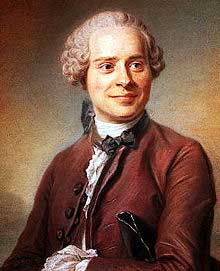.
Jean le Rond d'Alembert

Jean le Rond d'Alembert, pastel by Maurice Quentin de La Tour.
Jean le Rond d'Alembert (November 16, 1717 – October 29, 1783) was a French mathematician, mechanician, physicist and philosopher. He was also co-editor with Denis Diderot of the Encyclopédie. D'Alembert's method for the wave equation is named after him.
Childhood
Born in Paris, d'Alembert was the illegitimate child of the writer Claudine Guérin de Tencin and the chevalier Louis-Camus Destouches, an artillery officer. Destouches was abroad at the time of d'Alembert's birth, and a couple of days after birth his mother left him on the steps of the Saint-Jean-le-Rond de Paris church. According to custom, he was named after the patron saint of the church. D'Alembert was placed in an orphanage for found children, but was soon adopted by the wife of a glazier. Destouches secretly paid for the education of Jean le Rond, but did not want his parentage officially recognised.
Studies and adult life
D'Alembert first attended a private school. The chevalier Destouches left d'Alembert an annuity of 1200 livres on his death in 1726. Under the influence of the Destouches family, at the age of twelve D'Alembert entered the jansenist Collège des Quatre-Nations (the institution was also known under the name "Collège Mazarin"). Here he studied philosophy, law, and the arts, graduating as bachelier in 1735. In his later life, D'Alembert scorned the Cartesian principles he had been taught by the Jansenists: "physical premotion, innate ideas and the vortices".
The Jansenists steered D'Alembert toward an ecclesiastical career, attempting to deter him from pursuits such as poetry and mathematics. Theology was, however, "rather unsubstantial fodder" for d'Alembert. He entered law school for two years, and was nominated avocat in 1738.
He was also interested in medicine and mathematics. Jean was first registered under the name Daremberg, but later changed it to d'Alembert. In July of 1739 he made his first contribution to the field of mathematics, pointing out the errors he had detected in L'analyse démontrée (published 1708 by Charles René Reynaud) in a communication addressed to the Académie des Sciences. At the time L'analyse démontrée was a standard work, which D'Alembert himself had used to study the foundations of mathematics. D'Alembert was also a Latin scholar of some note and worked in the latter part of his life on a superb translation of Tacitus, from which he received wide praise including that of Denis Diderot.
In 1740, he submitted his second scientific work from the field of fluid mechanics Mémoire sur la réfraction des corps solides, which was recognized by Clairaut. In this work d'Alembert theoretically explained refraction. He also wrote about what is now called D'Alembert's paradox: that the drag on a body immersed in an inviscid, incompressible fluid is zero.
D'Alembert was a participant in several Parisian salons, particularly those of Madame Geoffrin, of the marquise du Deffand and of Mademoiselle de Lespinasse. There he met Denis Diderot.
When the Encyclopédie was organized in the late 1740s, d'Alembert was engaged as co-editor (for mathematics and science) with Diderot, and served until a series of crises temporarily interrupted the publication in 1757. He authored over a thousand articles for it, including the famous Preliminary Discourse.
Aged 23, he entered the Académie des sciences, and joined the Académie de Berlin at 28. In 1754, d'Alembert was elected a member of the Académie française, of which he became Permanent Secretary on 9 April 1772.
While he made great strides in mathematics and physics, d'Alembert is also famously known for incorrectly arguing in Croix ou Pile that the probability of a coin landing heads increased for every time that it came up tails. In gambling, the strategy of decreasing one's bet the more one wins and increasing one's bet the more one loses is therefore called the D'Alembert system, a type of martingale.
He suffered bad health for many years and his death was as the result of a bladder illness. As a known unbeliever, D'Alembert was buried in a common unmarked grave.
In France, the fundamental theorem of algebra is known as the d'Alembert/Gauss theorem.
He also created his ratio test, a test to see if a series converges.
He lived in an apartment with Julie de Lespinasse, a famous Parisian salonnière with whom he was infatuated.
Bibliography
* Grimsley, Ronald. (1963). Jean d'Alembert. Oxford: Clarenden Press.
* Briggs, J. Morton (1970). "Jean le Rond d'Alembert". Dictionary of Scientific Biography 1. New York: Charles Scribner's Sons. 110-117. ISBN 0684101149.
See also
Wave equation
D'Alembert's principle
Retrieved from "http://en.wikipedia.org/"
All text is available under the terms of the GNU Free Documentation License



